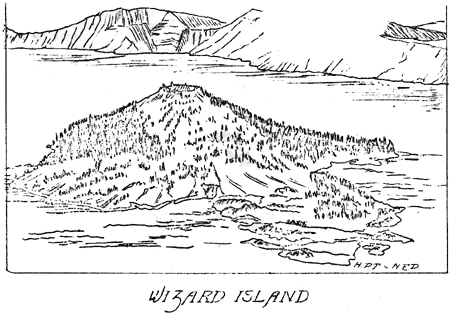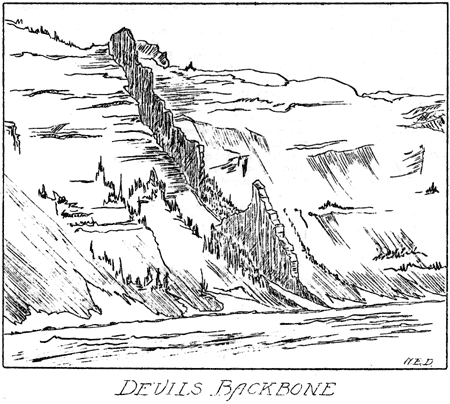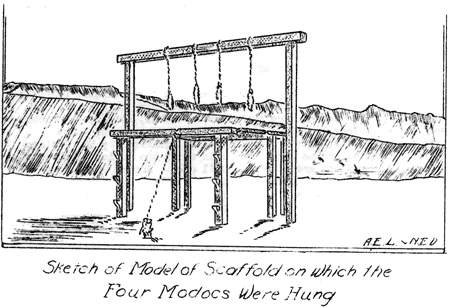On the west rim of Crater Lake, approximately 600 feet south of the Devil’s Backbone and 200 feet below the rim of the crater, there is a deposit of varved clays which resemble the typical varved clays associated with glacial deposits.
These clays are limited in extent, the greatest exposure being nearly six feet in thickness and thirty feet wide. Beyond, a mantle of brush obliterates all trace of the clays. Farther south of the exposure a lava flow rises above the elevation of the clay deposit. No trace of the clays can be found either at that point or farther south.
The thick growth of brush is due to moisture issuing at the top of the clay. Since the material above is definitely glacial in that it consists of typical morainal debris, it accordingly is more porous than the clay. The spring which supplies water for the North Entrance Ranger Station issues at the top of the clay deposit. In general the structure of the crater wall favors a westward drainage away from the lake; however, there may have been a small basin in which the clay was deposited which causes drainage toward the lake. Such a feature would be only local in character.
In both directions, north and south of the exposed varved clays, toward the Devil’s Backbone and Hillman Peak respectively, the glacial deposits are more sandy, although a few irregular sand clay layers may be traced through the deposits. In several places, the most notable of which occurs along the trail to the spring, there are deposits of well stratified, water deposited sand. These glacial and fluvio-glacial deposits are further evidence that the entire western slope of Mount Mazama was covered by ice having a thickness of several hundred or perhaps a thousand feet in places. Morainal deposits to the southwest of Hillman Peak certainly indicate extensive glaciation on the west slope of the ancient peak. Only Watchman and Hillman, the two peaks on the west rim of Crater Lake may have projected above the ice sheet.
The varved clays rest on a series of lava flows. No glacial striae were found on the surface of the flow directly beneath the clays. The banding in the clays is uniform and regular, the varves being evenly spaced. The varved character of the deposit indicates definitely deposition of fine sediment in a body of quiet standing water. Such a body of water may have existed during an inter-glacial stage, the water being held in place by morainal material and the ice. During an advance of the ice they clays, if frozen, may have remained undisturbed by the overriding ice. There is also the possibility that the deposit represents deposition in a dammed subglacial stream beneath stagnant ice, in which case the glacial debris above the clays settled out of the ice as it melted.
The section including the varved clays, the glacial drift above and the underlying lava flows, was exposed when the peak of Mount Mazama was destroyed.
*During the summer of 1937 the Civilian Conservation Corps provided funds for employing college students majoring in some particular field of work. Mr. Brown served as a Student Technician in Geology, his activities being under the direct supervision of the Naturalist staff of Crater Lake National Park.
Outline Of Events In The History Of The Modoc War
John E. Doerr, Jr., Park Naturalist
(Continued from the July 1937 issue of Nature Notes)
Parts I and II of this outline appeared in the June and July 1937 issues of Nature Notes. The first part covered the period 1846 – 1870, the second part 1871 to April 12, 1873, ending with the murder of General E. R. S. Canby and Reverend E. Thomas at the peace tent within what is now Lava Beds National Monument.
This part concludes the outline of events in the history of the Modoc War, a struggle which began in 1846 when the South Emigrant Trail, (Applegate Trail) was established through the Klamath Basin of southern Oregon and northern California, and ending with the death of some and exile of the other members of Captain Jack’s band of Modoc Indians.
Part III
April 12 – October 3, 1873
| 1873 April | Attack on The Stronghold. |
| Treachery on the part of the Modocs resulting in the death of General E. R. S. Canby and Reverend E. Thomas on April 11, 1873, ended the efforts of the Peace Commission. The U. S. Army made preparations to attack The Stronghold. On April 15 a general attack began, troops advancing from Gillem’s camp on the west and Mason’s camp at Hospital Rock, northeast of The Stronghold. Fighting continued throughout the day, the troops remaining in position during the night. Each advance of troops on the 16th was under heavy fire from the Modoc positions. That night the troops succeeded in cutting the Indians off from their water supply at the shore of Tule Lake. By the morning of April 17 everything was in readiness for the final attack on The Sronghold. When the order was given to advance, the troops charged into The Stronghold. | |
| The Stronghold Abandoned. | |
| After the fighting along the shoreline of Tule Lake on the afternoon and night of April 16, the Modocs defending The Stronghold realized that their water supply had been cut off by the troops commanding the shoreline. On April 17, before the troops had received the order to charge The Stronghold, the Indians escaped through a crevice left unguarded during a movement of troops from one position to another. During the fighting at The Stronghold, April 15 – 17, casualties included one officer and six enlisted men killed, and thirteen enlisted men wounded. The Indians suffered no casualties, except one boy, reported to have been killed when a cannon ball, which he was attempting to open with an axe, exploded. Several Modoc women were reported to have died from sickness. | |
| Thomas-Wright Massacre, April 26, 1973. | |
| On April 26 Captain Evan Thomas commanding five officers, sixty-six troops and fourteen Warm Spring Scouts left Gillem’s camp on a reconnaissance of the lava beds to locate the Indians. While eating lunch in a flat area surrounded by ridges, Captain Thomas and his party were attacked. Some of the troops fled in disorder. Those who remained to fight were either killed or wounded. Casualties included four officers killed and two wounded, one dying within a few days, and thirteen enlisted men killed and sixteen wounded. | |
| May | On May 2 General Jefferson C. Davis relieved Col. Alvin C. Gillem of the command of troops in the lava beds.U. S. troops and members of Captain Jack’s band of Modocs skirmished at Scorpion Point, May 7.General Davis ordered a reconnaissance to locate the Indians.Battle of Dry Lake. |
| As daylight on May 10 the Indians attacked the troops camped at Dry Lake. The troops charged, routing the Indians. Casualties among the troops included five men killed, two of whom were Warm Spring Scouts, and twelve men wounded. The Indians reported five warriors killed. Among the five was Ellen’s Man, a prominent Modoc. That was the first defeat of the Modocs in battle. The death of Ellen’s Man caused dissension among the Indians. | |
| June | Captain Jack captured in Langell’s valley, June 4.Preparations made to execute the Modoc leaders. |
| With the capture of Captain Jack, General Davis made preparations to execute the leaders of Jack’s band. Execution was prevented by orders from the War Department. The orders were that the Indians would be held for trail. | |
| July | Modoc prisoners arrived at Fort Klamath. |
| On July 4 Captain Jack and his band of Indians arrived as prisoners of war at Fort Klamath. | |
| Trial. | |
| Captain Jack, John Schonchin, Black Jim, Boston Charley, Brancho (Barncho) and Slolux were immediately put on trial for the murder of members of the Peace Commission. The six Indians were found guilty, and on July 8 they were sentenced to die. | |
| September | |
| On September 10 President U. S. Grant approved the death sentence for Captain Jack, John Schonchin, Black Jim and Boston Charley; Brancho and Slolux were committed to life imprisonment. President Grant also ordered that the remainder of Captain Jack’s band be held as prisoners of war. | |
| October | The End. |
| On October 3, 1873, Captain Jack, John Schonchin, Black Jim, and Boston Charley were hanged at Fort Klamath. The remainder of the band of Modoc Indians, consisting of 39 men, 64 women, and 60 children, as prisoners of war were sent to the Quaw Paw Agency in Indian Territory (Oklahoma). | |
Appendix to the Outline of Events in the History of the Modoc War
In the attack on The Stronghold, January 17, 1873, there were approximately 400 troops in the field. The troops included U. S. Army infantry, cavalry, and howitzer units; Oregon and California volunteer companies, and some Klamath Indian Scouts. Lt. Col. Frank Wheaton was in command of all troops.
In the capture of The Stronghold, April 17, 1873, approximately 530 troops were engaged. These included U. S. Army infantry, cavalry, and artillery, and Warm Spring Indian Scouts. The volunteer companies had withdrawn from the field. A small number of civilians were used as runners and packers. Col. Alvin C. Gillem was in command.
At no time during the Modoc War were there more than 53 Modoc warriors engaged in the fighting.
The casualty lists for the Modoc War are as follows:
| Rank | Killed | Wounded |
| Officers (U.S.A.) | 7 | 4 |
| Enlisted Men | 39 | 61 |
| Civilians | 16 | 1 |
| Indian Scouts | 2
|
0
|
| 64 | 66 |
Including the four Indians hung at Fort Klamath, Captain Jack’s band suffered the loss of seventeen warriors killed.
It has been estimated that the Modoc War cost the United States over $4,000,000; a very expensive war in terms of lives and dollars, considering the small number of opposing forces.
Battlefields of the Modoc War are among the outstanding features of the Lava Beds National Monument. These include The Stronghold in and around which one can see the numerous cracks, ridges, and knobs used by the Indians in defending their position, numerous Modoc outpost fortifications, smoke-stained caves inhabited by the Indians during the months of the war, corrals in which the Indians kept cattle and horses, war-dance ground and council area. Around The Stronghold one can see numerous low stone fortifications built by troops advancing on The Stronghold, as well as numerous fortifications built by the troops after the evacuation of the Modocs, the fortifications built after evacuation being for the purpose of defending The Stronghold in the event that the Indians should attempt to return to their former strong defensive position. The Thomas-Wright Massacre battlefield, near Hardin Butte, is one of the interesting features of the monument; as is also the site of Gillem’s camp, the former military cemetery, Hospital Rock, and Canby’s Cross.
Fishing In Crater Lake, August 1937
By Arthur D. Hasler, Ranger Naturalist and John E. Doerr, Jr., Editor
In the July 1937 issue of Nature Notes Volume X, Number 2, appears an analysis of the records of fish caught from boats on Crater Lake during July 1937. The following chart is a similar analysis of the catch for August 1937.
This is the first season that a study extending over a two months period has been made of the fish caught in Crater Lake. With such studies, along with the investigation of other aspects of the biology of Crater Lake, continuing over several seasons, it should be possible to look forward to the time when many of the questions relative to the fish and fishing in Crater Lake can be answered.
ANALYSIS OF THE RECORDS OF CATCH FROM BOATS ON CRATER LAKE*
August 1937
|
|
||||
| No. of Boat Reports |
No. of Anglers |
Total Fishing Hours |
No. of Fish Taken |
Catch Per Angler Per Hour |
|
|
||||
| 318 | 666 | 794 | 535 | 0.67 |
|
|
||||
*From a seasonal report prepared by Ranger Naturalist Arthur D. Hasler, Crater Lake National Park, September 1937.
Errata
By W. T. Frost, Ranger and
John E. Doerr, Jr., Park Naturalist
The following data should be added and the indicated correction made to the data appearing in Nature Notes, Volume X, No. 1, June 1937, page 6.
| Year | Low Lake Level of the Year |
Number of Feet Below High Point of 1910 |
| 1931 | 6163.26 | 13.91 |
| 1932 | 6163.71 | 13.46 |
| 1933 | 6164.46 | 12.71 |
The lowest level on record was in 1931 rather than in 1934 as is indicated in the June 1937 issue of Nature Notes.
Web Edition Note: In the online edition of Nature Notes, June 1937, the table has already been corrected to reflect the above changes.
***previous*** — ***next***





